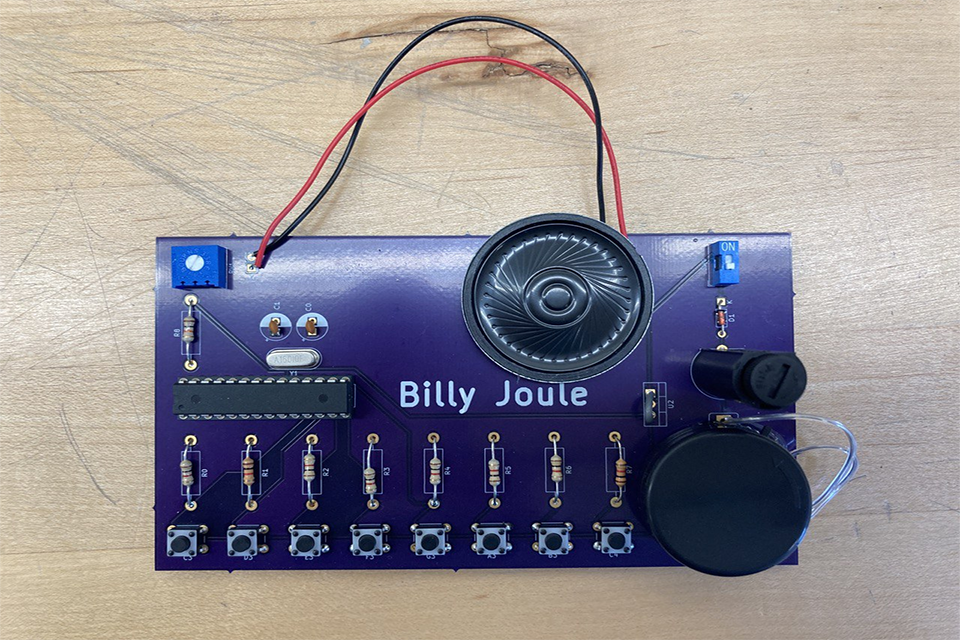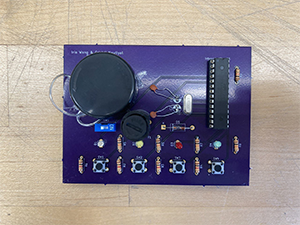From ‘Simon Says’ to ‘Billy Joule’: Students create electronic games from scratch


‘Simon Says’ is a memory game where players repeat a sequence of colors.
Francesco Vischi wanted students in his Electronics Laboratory course to apply what they learned in the classroom to real-world technology. So, he decided to teach them how to create their own electronic games - from scratch.
The course, offered every spring as an introduction to electronics in a lab setting, covers topics like analog, digital electronics and printed circuit board design.
The course incorporates a variety of electronic experiments throughout the semester. This year, however, was the first time students created projects using industry level printed circuit boards.
Vischi explained the significance of learning to use printed circuit boards, referred to as PCBs. Used as the industry standard in gaming systems, military equipment, medical technology and more, these pieces are fundamental in the world of technology.
“Using PCBs in class is like teaching artists to use canvas, paint and a brush,” he said. “The actual result can range from a simple smile to sky-is-the-limit.”
Vischi had the help of teaching assistant and physics PhD candidate Rupam Saha in guiding the 15 students to create their projects, ranging from electronic games to light switches.
Choosing from a list of ideas, students who chose to create games built a digital game die, a ‘Simon Says’ memory game where players repeat a sequence of colors, and ‘Billy Joule,’ an electronic piano with a name that plays on ‘joule, ’the term for a derivative unit of energy.
Regardless of what students chose to create, the biggest thing Vischi emphasized was teamwork.
“I was really impressed with their results, seeing them work together as a team,” said Vischi. “The biggest thing I hope they took away from the project was the power of collaboration.”
Staring from scratch, the teams used electronic breadboards to begin their projects. These small construction pieces, only a couple of inches wide with small holes for inputting pieces, are used for creating electronic prototypes. Students learned the value of attention to detail when working with technology.
“A single mistake can easily make the whole project fall down,” said Vischi. “They learned the need to manage their time and know their strengths and weaknesses,” said Vischi.
Iria Wang ’22, a student in the course who created a ‘Simon Says’ board, enjoyed seeing the process of creating the game from start to finish.
“The most helpful part of the course was going through the design process and learning about prototype implementation,” she said. “We had to learn to work as a team while troubleshooting any issues that came up.”
A double major in physics and computer science, took Vischi’s course because she wanted to gain experience in electronics. After graduating, she will be working for the ATLAS experiment at CERN, a national nuclear physics experiment involving scientists across the world, and begin taking courses towards a PhD in physics at Harvard University.
“As a physicist, it’s important to be able to work with electronics,” said Wang. “I wanted to graduate from Brandeis with skills I could apply to my career.”
When the design and prototype portions of the project were completed, teams moved on to creating the final product using the printed circuit boards.
“These fun projects show how such electronic circuits are actually implemented in the industry,” said Saha. “I didn’t have an opportunity like this during my undergraduate courses. Our students had learned how electronics work in the real world.”
Categories: General, Science and Technology, Student Life





